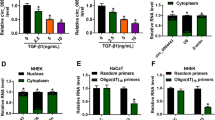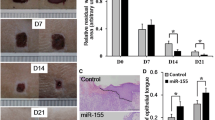Abstract
Circular RNA protein kinase, DNA-activated, catalytic subunit (circ_PRKDC) has been found to impede wound healing in diabetic foot ulcers via regulating keratinocyte proliferation and migration. However, the mechanisms underlying circ_PRKDC in skin wound healing remain unclear. The expression of circ_PRKDC, microRNA (miR)-31 and fibrillin 1 (FBN1) was detected using quantitative reverse transcription-polymerase chain reaction and Western blot assays. The migration ability and the changes of matrix metallopeptidase 9 (MMP-9) and MMP2 levels were determined using wound healing, transwell and Western blot assays. The interaction between miR-31 and circ_PRKDC or FBN1 was verified by dual-luciferase reporter assay. The expression of circ_PRKDC was gradually down-regulated in wound edge at 1 and 7 days after injury relative to the unwounded skin. In human epidermal keratinocytes (HEKa), knockdown of circ_PRKDC promoted cell migration partly through up-regulating MMP-2 and MMP9, while circ_PRKDC overexpression showed opposite effects. In a mechanical study, we confirmed that miR-31 was a target of circ_PRKDC, and inhibition of miR-31 reversed the promotive effect of circ_PRKDC knockdown on HEKa migration. Besides that, miR-31 was verified to target FBN1, and ectopic overexpression of miR-31 accelerated HEKa migration via FBN1. Importantly, we also demonstrated that FBN1 overexpression attenuated the effects of circ_PRKDC knockdown on HEKa migration. In all, circ_PRKDC knockdown promoted HEKa migration during wound healing through miR-31/FBN1 axis, suggesting the therapeutic potential for circ_PRKDC on skin wound healing.








Similar content being viewed by others
References
Ashworth JL, Murphy G, Rock MJ, Sherratt MJ, Shapiro SD, Shuttleworth CA, Kielty CM (1999) Fibrillin degradation by matrix metalloproteinases: implications for connective tissue remodelling. Biochem J 340(1):171–181
Bian D, Wu Y, Song G (2018) Novel circular RNA, hsa_circ_0025039 promotes cell growth, invasion and glucose metabolism in malignant melanoma via the miR-198/CDK4 axis. Biomedicine pharmacotherapy = Biomedecine pharmacotherapie 108:165–176
Du WW, Zhang C, Yang W, Yong T, Awan FM, Yang BB (2017) Identifying and characterizing circRNA-protein interaction. Theranostics 7(17):4183–4191
Eming SA, Martin P, Tomic-Canic M (2014) Wound repair and regeneration: mechanisms, signaling, and translation. Science translational medicine 6(265):265sr266
Falanga V (2005) Wound healing and its impairment in the diabetic foot. Lancet 366(9498):1736–1743
Guo P, Huang J, Zhang J, Meng C, Zhang S, Bai Y, Ning Z, Hu L (2019) The potential role of circRNA_004229 in hair/epidermal regulation after MED1 ablation in keratinocytes. RSC Advances 9(33):19095–19103
Han JA-O, LaVigne CA-O, Jones BA-OX, Zhang HA-O, Gillett FA-O, Mendell JA-O (2020) A ubiquitin ligase mediates target-directed microRNA decay independently of tailing and trimming. Science. https://doi.org/10.1126/science.abc9546
Hansen TB, Jensen TI, Clausen BH, Bramsen JB, Finsen B, Damgaard CK, Kjems J (2013) Natural RNA circles function as efficient microRNA sponges. Nature 495(7441):384–388
Hattori N, Mochizuki S, Kishi K, Nakajima T, Takaishi H, D’Armiento J, Okada Y (2009) MMP-13 plays a role in keratinocyte migration, angiogenesis, and contraction in mouse skin wound healing. Am J Pathol 175(2):533–546
Jeck WR, Sharpless NE (2014) Detecting and characterizing circular RNAs. Nature biotechnology 32(5):453–461
Jo DH, Yun JH, Cho CS, Kim JH, Kim JH, Cho CH (2019) Interaction between microglia and retinal pigment epithelial cells determines the integrity of outer blood-retinal barrier in diabetic retinopathy. Glia 67(2):321–331
Kessenbrock K, Plaks V, Werb Z (2010) Matrix metalloproteinases: regulators of the tumor microenvironment. Cell 141(1):52–67
Krishnaswamy VR, Korrapati PS (2014) Role of dermatopontin in re-epithelialization: implications on keratinocyte migration and proliferation. Scientific reports 4:7385
Lan CC, Liu IH, Fang AH, Wen CH, Wu CS (2008) Hyperglycaemic conditions decrease cultured keratinocyte mobility: implications for impaired wound healing in patients with diabetes. Br J Dermatol 159(5):1103–1115
Lewis CJ, Mardaryev AN, Poterlowicz K, Sharova TY, Aziz A, Sharpe DT, Botchkareva NV, Sharov AA (2014) Bone morphogenetic protein signaling suppresses wound-induced skin repair by inhibiting keratinocyte proliferation and migration. J Invest Dermatol 134(3):827–837
Li D, Li XI, Wang A, Meisgen F, Pivarcsi A, Sonkoly E, Ståhle M, Landén NX (2015) MicroRNA-31 Promotes Skin Wound Healing by Enhancing Keratinocyte Proliferation and Migration. J Invest Dermatol 135(6):1676–1685
Liu R, Wang Q, Chang W, Zhou L, Li J, Zhang K (2019) Characterisation of the circular RNA landscape in mesenchymal stem cells from psoriatic skin lesions. European journal of dermatology: EJD 29(1):29–38
Mäkelä M, Larjava H, Pirilä E, Maisi P, Salo T, Sorsa T, Uitto VJ (1999) Matrix metalloproteinase 2 (gelatinase A) is related to migration of keratinocytes. Experimental cell research 251(1):67–78
Marques-Rocha JL, Samblas M, Milagro FI, Bressan J, Martínez JA, Marti A (2015) Noncoding RNAs, cytokines, and inflammation-related diseases. FASEB journal: official publication of the Federation of American Societies for Experimental Biology 29(9):3595–3611
Martins VL, Caley M, O’Toole EA (2013) Matrix metalloproteinases and epidermal wound repair. Cell tissue research 351(2):255–268
Raja, Sivamani K, Garcia MS, Isseroff RR (2007) Wound re-epithelialization: modulating keratinocyte migration in wound healing. Frontiers in bioscience: a journal virtual library 12:2849–2868
Redd MJ, Cooper L, Wood W, Stramer B, Martin P (2004) Wound healing and inflammation: embryos reveal the way to perfect repair. Philosophical transactions of the Royal Society of London Series B Biological sciences 359(1445):777–784
Rohani MG, Parks WC (2015) Matrix remodeling by MMPs during wound repair. Matrix biology: journal of the International Society for Matrix Biology 44–46:113–121
Sheu-Gruttadauria J, Pawlica P, Klum SM, Wang S, Yario TA, Schirle Oakdale NT, Steitz JA, MacRae IJ (2019) Structural Basis for Target-Directed MicroRNA Degradation. 75:1097–4164
Shi J, Ma X, Su Y, Song Y, Tian Y, Yuan S, Zhang X, Yang D, Zhang H, Shuai J et al (2018) MiR-31 Mediates Inflammatory Signaling to Promote Re-Epithelialization during Skin Wound Healing. J Invest Dermatol 138(10):2253–2263
Shin KO, Choe SJ, Uchida Y, Kim I, Jeong Y, Park K (2018) Ginsenoside Rb1 Enhances Keratinocyte Migration by a Sphingosine-1-Phosphate-Dependent Mechanism. J Med Food 21(11):1129–1136
Shiroto Y, Terashima S, Hosokawa Y, Oka K, Isokawa K, Tsuruga E (2017) The Effect of Ultraviolet B on Fibrillin-1 and Fibrillin-2 in Human Non-pigmented Ciliary Epithelial Cells In Vitro. Acta histochemica et cytochemica 50(3):105–109
Si C, Wang J, Ma W, Hua H, Zhang M, Qian W, Zhou B, Luo D (2019) Circular RNA expression profile in human fibroblast premature senescence after repeated ultraviolet B irradiations revealed by microarray. Journal of cellular physiology 234(10):18156–18168
Wang M-L, Chen J, Zhou Y, Zhao Y-J, Sun D-R, Wu Q, Bi C-L (2018) MiR-503 promotes wound healing of diabetic foot ulcer by targeting FBN1. Asian Pacific Journal of Tropical Medicine 11(3):245–250
Wang A, Toma MA, Ma J, Li D, Vij M, Chu T, Wang J, Li X, Xu Landén N (2020) Circular RNA hsa_circ_0084443 Is Upregulated in Diabetic Foot Ulcer and Modulates Keratinocyte Migration and Proliferation. Advances in wound care 9(4):145–160
Wilusz JE, Sharp PA (2013) Molecular biology. A circuitous route to noncoding RNA. Science 340(6131):440–441
Woodley DT, O’Keefe EJ, Prunieras M (1985) Cutaneous wound healing: a model for cell-matrix interactions. J Am Acad Dermatol 12(2 Pt 2):420–433
Wu X, Xiao Y, Ma J, Wang A (2020) Circular RNA: A novel potential biomarker for skin diseases. Pharmacological research 158:104841
Yang L, Zheng Z, Zhou Q, Bai X, Fan L, Yang C, Su L, Hu D (2017) miR-155 promotes cutaneous wound healing through enhanced keratinocytes migration by MMP-2. J Mol Histol 48(2):147–155
Yang ZG, Awan FM, Du WW, Zeng Y, Lyu J, Wu D, Gupta S, Yang W, Yang BB (2017) The Circular RNA Interacts with STAT3, Increasing Its Nuclear Translocation and Wound Repair by Modulating Dnmt3a and miR-17 Function. Molecular therapy: the journal of the American Society of Gene Therapy 25(9):2062–2074
Zhao P, Sui BD, Liu N, Lv YJ, Zheng CX, Lu YB, Huang WT, Zhou CH, Chen J, Pang DL et al (2017) Anti-aging pharmacology in cutaneous wound healing: effects of metformin, resveratrol, and rapamycin by local application. Aging cell 16(5):1083–1093
Funding
None.
Author information
Authors and Affiliations
Corresponding author
Ethics declarations
Conflict of interest
The authors declare that they have no financial conflicts of interest.
Ethical approval
Our study was approved by the Ethics Committee of The First Affiliated Hospital of Zhengzhou University and was conducted in accordance with the Declaration of Helsinki.
Additional information
Publisher’s Note
Springer Nature remains neutral with regard to jurisdictional claims in published maps and institutional affiliations.
Rights and permissions
About this article
Cite this article
Han, D., Liu, W., Li, G. et al. Circ_PRKDC knockdown promotes skin wound healing by enhancing keratinocyte migration via miR-31/FBN1 axis. J Mol Histol 52, 681–691 (2021). https://doi.org/10.1007/s10735-021-09996-8
Received:
Accepted:
Published:
Issue Date:
DOI: https://doi.org/10.1007/s10735-021-09996-8




